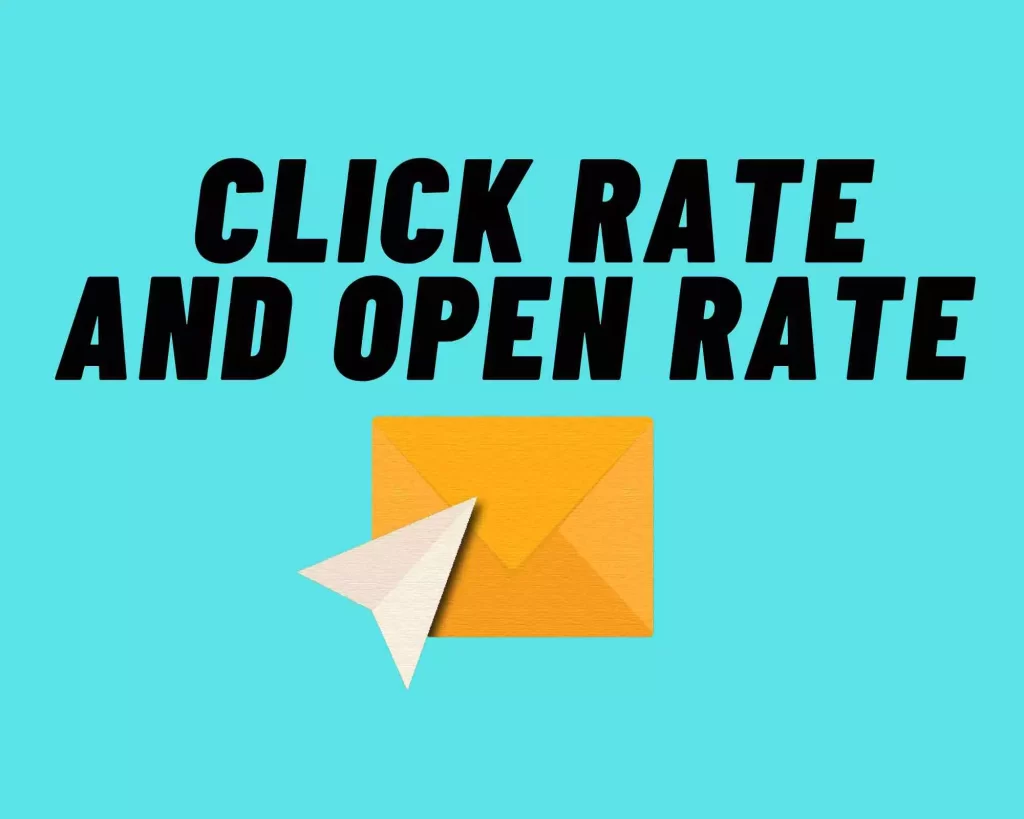The most often utilized metrics in email marketing are click rate and open rate, but What Is The Difference Between Click Rate And Open Rate?
One measures the proportion of emails that were opened by recipients, while the other measures the number of times links were clicked inside an email.
Is that all? NO.
Having a better understanding of the difference between click rate and open rate may help you improve your email marketing performance and make data-driven choices to achieve better outcomes.
In this blog article, we’ll dive deeper into the definitions of click rate and open rate, explain the factors that might impact these metrics, and explain how you can utilize these data to get the best from your email marketing efforts.
Please read our guide on how to get customers to open your email.
Let’s get started with what click rate is.
What Is Click Rate, And What Does It Measure?
The click rate, also known as the click-through rate (CTR), is a metric used in email marketing that compares the number of clicks on a link to the number of emails sent.
It is measured by dividing the number of clicks on a link in an email by the number of emails successfully sent to recipients and multiplying the result by 100.
The number of clicks on the links in your email campaigns is tracked to determine the degree of engagement of your email subscribers. A high click rate suggests that your email content and calls to action successfully drive engagement and motivate recipients to act. A poor click rate, on the other hand, may indicate that your email content is not reaching your target audience or that your calls-to-action need to be more transparent and compelling.
According to email marketing standards, the average click rate across all sectors is roughly 7.8%. Click rate information is helpful since it helps you determine which links are producing the most interaction and change your email content and calls-to-action appropriately. For example, suppose a link in your email campaign to a particular product has a considerably higher click rate than other links. In that case, you should showcase that product more prominently in future ads.
It is vital to remember that the click rate should not be regarded as the only metric for measuring the performance of an email campaign. Although high click rates indicate a successful email campaign, they may sometimes equate to conversions or money.
A high click rate indicates that receivers are interested in your material, but more is needed to ensure that they will buy or conduct other desirable activities.
What Is Open Rate, And What Does It Measure?
The open rate in email marketing is a metric that indicates the proportion of emails that recipients open.
It is measured by dividing the number of emails opened by the number of emails sent and multiplying the result by 100.
The open rate of your emails determines the efficiency of your subject lines and preheader content in attracting your subscribers’ attention and persuading them to read your emails.
A high open rate implies that your subject line and preheader text are striking a chord with your readers and piquing their interest in your email content. A poor available rate, on the other hand, may suggest that your subject line and preheader text could be more enticing or that your email content could be more relevant to your target.
Email marketing benchmarks show that the average open rate across all sectors is roughly 21.3%. It’s crucial to note that your email’s available rate may be influenced by a variety of factors, including the time of day and day of the week it was sent, the kind of email client your subscribers use, and the subject line and preheader text you used. For example, sending an email campaign on vacation when individuals are less likely to check their email may result in a reduced open rate.
The open rate is an excellent metric for determining how well your email campaigns create interest and interaction from your subscribers.
What Is The Importance Of Click Rate And Open Rate?
The two crucial email marketing metrics of click rate and open rate provide different but complementary perspectives on the effectiveness of an email campaign. Here’s why is the importance of both click rate and available rate:
Open Rate: The available rate shows email deliverability and subject line effectiveness.
A high open rate shows that the email was successfully delivered to the recipient’s inbox and that the subject line did an excellent job of grabbing their attention. The available rate may also provide information about how engaged subscribers are with the company.
Click Rate: The relevancy and efficacy of the email’s content and calls to action may be determined by looking at the click rate.
A high click-through rate shows that the information was exciting and relevant and that the calls to action successfully persuaded the reader to perform the intended action.
When combined, open and click rates provide a more accurate picture of an email campaign’s efficacy.
A high open rate may show that the subject line successfully drew readers’ attention.
While a low click rate can show that the calls to action or content were ineffective.
On the other side, a low open rate may point to an issue with email deliverability or an ineffective subject line, while a high click rate may suggest that the content and calls-to-action were successful.
In short, the open rate and click rate are crucial metrics that provide light on how successful an email campaign is.
What Is The Difference Between Opens And Clicks?
Both opens and clicks are crucial email marketing analytics, but they measure different elements of subscriber interaction.
Opens are the proportion of emails that were opened by recipients, while clicks are the number of times links inside an email were clicked.
The primary differentiation between openings and clicks is that opens are passive, while clicks are active.
A receiver may open an email to review the text, but they may not respond further by clicking on any links.
Conversely, a click reflects a recipient’s purposeful action in reaction to the email content, showing a greater degree of involvement.
The kind of information provided by opens and clicks is another distinction.
Opens reveal the success of your subject line and preheader text in attracting your audience’s attention.
While clicks reveal the effectiveness of your email content and call to action in boosting engagement and motivating subscribers to take action.
Recent email marketing benchmarks show that the average open rate across all sectors is roughly 21.3%, with a click rate of around 7.8%.
These criteria, however, vary significantly based on the business, the kind of email, and other aspects.
Although openings and clicks might give vital insights into the efficacy of your email marketing initiatives, they do not tell the whole picture.
A receiver, for example, may open an email but not click on any links, or they may not open the email but convert via another channel.
This is why, while measuring the efficacy of your email marketing, you should include a variety of measures, such as conversion rates, revenue earned, and total ROI.
In short, although both opens and clicks give valuable insights into subscriber engagement, they measure different interactive elements. They should be used in tandem with other metrics to analyze the performance of your email marketing efforts effectively.
What Factors Influence Click Rate And Open Rate?
Numerous variables may have an impact on the click and open rates of your email marketing, including:
1. Subject line and preheader text:
When your subscribers open your email, the subject line and preheader text are the first things they see.
A fascinating subject line and preheader content may enhance the likelihood of your email being opened.
2. Senders’ reputation:
The sender’s name and email address should be recognized and relevant to the receiver. Utilizing a personal or corporate name that the recipient acknowledges might enhance the probability that your email will be opened.
3. Email layout and design:
A visually beautiful and well-designed email may catch the recipient’s attention and motivate them to interact with your information.
On the other hand, a poorly designed or crowded email might turn off the receiver and reduce the likelihood of them going through to your website or landing page.
4. Email content:
Your email should be relevant, entertaining, and beneficial to your readers.
Delivering relevant information to your subscribers’ needs and interests may boost their likelihood of clicking on your links.
5. Timing:
Your email campaign’s timing might impact the open and click rates.
Sending emails at the proper time may boost the likelihood that your subscribers will notice and interact with your email.
For example, sending an email before the start of the workday may enhance the odds of it being viewed and opened.
6. Email list quality:
Your email list’s quality might impact your open and click rates.
Possessing a list of engaged and interested subscribers who have opted in to receive your emails increases the likelihood that your emails will be opened and clicked on.
It’s vital to remember that these variables might differ depending on your industry, audience, and other circumstances.
Constantly monitoring and testing these variables helps you determine what works and does not for your email marketing and audience.
How Do You Increase the Open Rate And Click Rate?
You may use the following tactics to boost your email open and click rates:
1. Improve your subject line and preheader text:
A clear and captivating subject line and preheader language may entice readers to open your email and interact with your content.
Experiment with subject lines and preheader content to see what works best for your target demographic.
2. Segment your email list:
Segmenting your email list enables you to send targeted emails to particular groups of subscribers, boosting the relevance and value of your emails and resulting in increased engagement rates.
3. Improve your email content:
Your email’s content should be relevant, helpful, and simple to understand.
Use brief paragraphs, bullet points, and eye-catching graphics to make your material more interesting.
4. Personalize your emails:
Addressing readers by name, for example, may enhance engagement and establish a closer relationship with your audience.
5. Testing and optimizing
Constantly test and tweak your email campaigns by evaluating your data and making data-driven choices to boost your open and click rates.
6. Make your emails mobile-friendly:
As more people check their emails on mobile devices. It is critical that your emails be mobile-friendly and simple to read and engage with on smaller displays.
You may improve your email marketing performance and obtain greater open and click rates by using these tactics.
But. Remember that the best tactics for improving the open rate and click rate might differ. Based on your audience and business, so experiment and test to find out what works best for your circumstance.
Conclusion
Now that you’ve learnt the difference between click rate and open rate.
Click rate and open rate are key email marketing metrics that may help you assess the efficiency of your email campaigns and audience engagement.
Open rate is the proportion of recipients who opened your email. At the same time, the click rate is the percentage of recipients who clicked on a link inside your email.
Knowing the difference between these indicators will assist you in better analyzing and optimizing your email marketing.
You can optimize your email campaigns and boost your chances of engaging your audience and reaching your marketing objectives. By paying attention to the aspects that drive these KPIs, such as subject lines, sender name, email content, and email list quality.
Frequently Asked Question
Why Are Clicks Higher Than Opens?
Since clicks show more significant interaction with the email content than opens, they are often higher than openings.
In other words. A receiver who clicks on a link inside an email has not only opened the email but also done action within it. Such as reading an article, making a purchase, or downloading a resource.
On the other hand. Opens signal that the email was opened. And provide no information on the recipient’s degree of engagement or involvement with the email.
Moreover, specific email applications. Such as Google, show the content of an email in the preview pane without actually opening the email, which might increase the click rate while decreasing the open rate.
Which Is More Insightful Open Rate Or Click-Through Rate?
When measuring the insight of your email marketing, both open rate and click-through rate may give helpful insight.
But, the click-through rate is more insightful since it suggests a more significant interaction with your email content.
Although the open rate is a solid sign of how well your email subject line and preheader text are functioning. It tells you little about how your receivers engage with your email content.
But, the click-through rate gives you a better insight into what connects with your audience. And what actions they are most likely to take. By displaying the number of receivers who took action and interacted with your email content.
By paying attention to both indicators. You can better understand your email campaigns’ effectiveness and make data-driven choices to enhance your future email marketing efforts.





